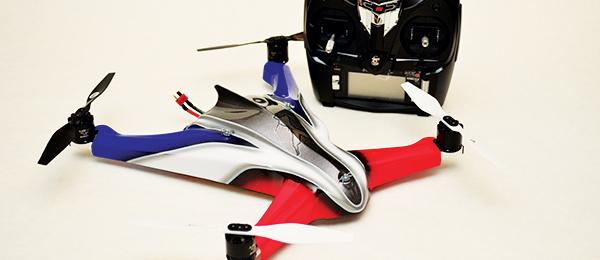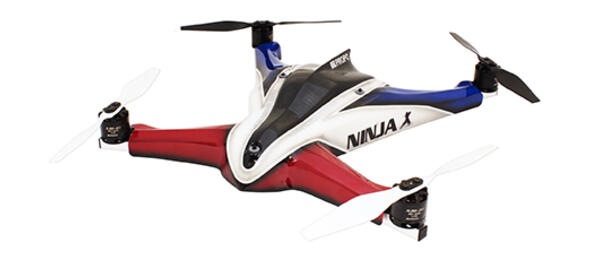Your 3-D flight experience awaits.
Article, photos, and video by Chris Mulcahy
Read the full article in the August 2015 issue of Model Aviation.
Multirotor is definitely a buzzword these days and most of the time it’s used in reference to high-tech, self-stabilizing, GPS-guided camera platforms. A small percentage of multirotors, however, are used for something slightly different. These aircraft do not have GPS guidance, they don’t carry a camera, and did I mention that they can hover upside down? 3-D quadcopters are incredibly fun and challenging to fly. Although some use variable-pitch propellers, similar to a helicopter tail rotor, this quadcopter uses a fixed-pitch propeller and can reverse the motor direction almost instantly when flipping upside down. JR Americas is known for its quality transmitters and helicopters, and has now brought something different into the mix in the form of its new Ninja 400MR. The Ninja is a 400mm aerobatic quadcopter, and is available in two flavors. The Ready to Fly (RTF) Ninja comes with a JR XG6 transmitter, or you can purchase the kit which requires you to build it and add your own DMSS-compatible transmitter. Both versions require a flight battery. In this case, it’s a three-cell 2,200 mAh pack. The Ninja has a failsafe built into it in case you accidentally bump the throttle stick when connecting the flight battery. If you move the throttle stick up, nothing will happen. You have to move the throttle stick slightly above low stick for the motors to start to turn. You need to hold the stick there for a few seconds and you will hear the tone of the motors change when it is ready to fly. At this point, you can throttle up and lift off. The Ninja has two flight modes: normal and 3-D. In normal mode, the JR Ninja is incredibly stable. It self stabilizes and is a forgiving quadcopter to fly. You have to remember that this multirotor does not have GPS—it was not designed for that. Although it is super stable, it will drift with the wind. Sport flying the Ninja is a simple process. If you get into trouble you can let go of the stick and allow it to self-stabilize. It feels as though there is a lot of exponential in this mode. Long stick movements are required to get the Ninja to respond. It is very docile, and beginners will find it an ideal quadcopter to learn with. I found the best way to land was to bring it close to the ground (almost touching) and switch on throttle hold for an uneventful landing. The 3-D mode is a different story. For your first time switching into 3-D mode (or idle up for helicopter pilots), you need to maintain a little altitude until you are used to the transition. The self-stabilization feature turns off and you are ready to rock and roll. The throttle stick becomes much like a collective stick on a helicopter. Mid stick shuts the motors off, from mid to high stick provides positive pitch, and mid to low stick gives you negative pitch. The pitch never changes. The motors are simply switching direction and speed at a remarkable rate. The Ninja’s responsiveness also increases tenfold. It becomes extremely agile, and all traces of that exponential feeling in sport mode evaporate. It starts to feel more like a 3-D helicopter. The roll/flip rate is fairly fast, and I found that the multirotor behaves the same upside down as it does right side up. The first few flips taught me the timing I needed to transition from positive to negative flight. As with all quadcopters in this class, it feels like a helicopter with a slight lag in collective pitch when transitioning from positive to negative. After a couple of quick flights, I started to get the hang of it and have a lot of fun. In forward flight, you can pick up a good amount of speed. It felt pretty fast. Flips were easy to do, and I tried some Tic-Tock-style maneuvers too. In my case, the Tic-Tocks looked more like rainbows, but it was fun nonetheless. I want to try some pirouetting flips, but I figured I better get some spare propellers before giving that one a try! One test that I like to do with multirotors is to pirouette and suddenly stop. This tells me a lot about the setup based on how much bounce I get. The Ninja had no bounce. No matter how hard I spun it around and abruptly stopped it, the Ninja stopped exactly where I told it to with no bounce back. This impressed me—it gives the Ninja a crisp and precise feeling in flight. I had a blast flying the Ninja. It feels light and nimble in the air, and with my 3-D flying style I was able to get an easy four minutes of flight. I wish I could get more flight time out of it, but I fear that a larger battery would shift the center of gravity, upsetting the Ninja’s flying characteristics (that is if you could fit a larger battery under the body shell, which would be tough to do). Luckily, there is an easy cure for that one: bring more batteries to the flying field! If you are looking for a fun 3-D quadcopter, this is a lot of fun for advanced pilots or a good place for beginners to start. Read the full article in the August 2015 issue of Model Aviation.










Comments
Add new comment